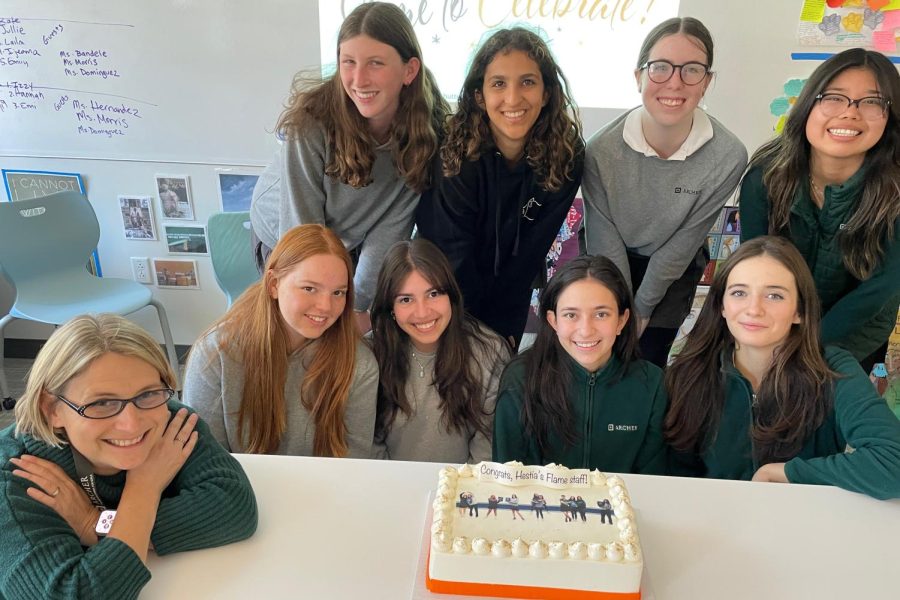Hestia’s Flame staff publishes 27th edition, reflects on in-depth, yearlong creation process
Photo credit: Kristin Taylor
The yearbook staff and Head of Scholastic Journalism Kristin Taylor gather around a cake in celebration of completing the 2022-2023 edition of the Hestia’s Flame. There have been 27 volumes of the yearbook, each tasked with reporting the most important, newsworthy moments of the school year.
June 1, 2023
While photos, emails and slideshows can capture moments, Hestia’s Flame captures an entire school year in 248 pages. A 10-person staff crafted the yearbook’s 27th volume to recap the 2022-2023 school year. They distributed it to seniors Tuesday, May 23, and to grades six through 11 the next day.
The theme of the 2022-2023 yearbook is Hearth, based on the Greek goddess Hestia, who the book is named after. Editor-in-Chief Charlotte Tragos (’23) said Hestia and her hearth, an area in front of a fireplace, were motifs of the book because of their symbolic significance to the school community.
“She’s responsible for gathering people around the fireplace, warming communities metaphorically, spiritually and physically,” Tragos said. “I thought of something [for the book’s theme] that would encapsulate our family coming together after tumultuous years apart … It’s what makes us passionate, what makes us spirited and what brings us together.”
Rachel Michiel (’25), an intro staffer, said Hestia’s Flame is often overlooked as a journalistic work, unlike The Oracle. She said the difference between the site and the book lies in their goals of timeliness versus timelessness.
“Everyone sees The Oracle as the mainstream student-led publication, but Ms. Taylor really does have two: Hestia’s Flame and The Oracle,” Michiel said. “Both are sources of news, but different kinds. The Oracle posts very current news, whereas the yearbook will … be remembered in 20 years. It’s very much a staple of time at Archer.”
The yearbook is digitally created from August until March, when it is sent to a publishing company for print. After publishing last year’s book, the staff changed its publishing company. As a result, they now use Monarch, which contains InDesign and additional features to make spreads. Managing Editor Anna Entin (’24) said adjusting to this change was a gradual but effective process.
“It definitely was a bit difficult at first, but something I love about the new company is there are aspects that are very user-friendly, like doing the index or spellcheck,” Entin said. “Once we got a couple of months in and things were going smoothly, I do think that moving to Jostens was a good choice.”
The staff uses a chronological structure for its coverage. Monthly coverage for fall, winter and part of spring includes art, academics, student life and special spreads, which cover annual, school wide events like Color Wars and Spirit Week. Due to the staff’s small size, just one or two staffers were responsible for taking photos, gathering interviews and writing to complete their assigned spread.
To provide content for the remainder of the year while the yearbook prints, the staff filmed summative videos for April and May that are accessible through QR codes provided in the book. Tragos said, in addition to school events, Hestia’s Flame aims to report on broad topics through a localized lens.
“We attempt to cover not only students’ interactions with the Archer community but students’ experiences in the year,” Tragos said. “This means we extend our coverage to national issues like the Coronavirus, news events or local community issues that have had a direct impact on Archer.”
The yearbook has four major deadlines: one in the fall, two in the winter and one in spring. Once a spread is drafted in InDesign, staffers print their spreads on tabloid-sized paper to get written edits from peers, student editors, and Head of Scholastic Journalism Kristin Taylor. Editors submit revised spreads to Jostens to receive printed proofs, which the staff will make a final round of edits to. Finally, the Editor-in-Cheif will submit spreads a final time, ensuring they are ready to be in the book.
Tragos said despite the time management challenges posed by the creation process, the book’s physical manifestation was a gratifying reward.
“It’s always a struggle when the beautiful spread you imagined is not materializing, the deadline is approaching and you have 20 other things to do,” Tragos said. “But looking at the yearbooks I have on my wall, I am reminded of the importance of the work we’re doing … Seeing your work printed is always a rewarding payoff.”
Michiel said she joined the yearbook elective largely because of her interest in design. However, upon reflection, she said she realized design was also the most difficult part of making spreads.
“The most challenging [part] is knowing how to start because you can have your interviews, your captions and [your] photos, but it’s about: ‘How am I going to get these blank pages into [a] gorgeous spread?’ That’s a difficulty but also the best part,” Michiel said. “A lot of work goes into each spread, so much more than you think.”
Entin echoed Michiel’s sentiments, stating she hoped non-yearbook students could recognize the amount of work it takes to publish the yearbook. Entin said the steps needed to arrive at the end product may appear small, but are imperative for the cumulative result.
“It would be nice if people see the amount of effort every single person on staff puts in because so much work is done behind the scenes,” Entin said. “That one five-minute interview we had with someone in the Archer community is part of something so much larger.”
Tragos has been a staff member for four years, beginning as an intro staffer and later taking on roles of copy editor, managing editor and editor-in-chief. She said her editorial positions allowed her to become a high-quality leader.
“More than anything, I’ve learned how to be a thoughtful and compassionate leader,” Tragos said. “I came to the staff hesitant in my capabilities, shy and reserved. Through the opportunities I have been given to take a more active role as the leader, I have felt the trust of our small but mighty publication.”
Michiel said working on Hestia’s Flame has given her a closer look at Archer which deepened her connection to the school and gratitude for her contributions to the book.
“I’ve always felt connected to the Archer community, but I’ve never felt so appreciative of the community until I was able to work on this book because I was able to see all the people [from Archer] and how they celebrate through photos, captions and spirit from the staff,” Michiel said. “I’m so much more aware of everything that goes on in the school. Seeing all of that on the pages and then being able to then see myself on a page is really rewarding.”










